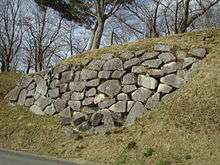Obama Castle (Mutsu Province)
Coordinates: 37°32′51″N 140°30′21″E / 37.547531°N 140.505917°E

Obama Castle (小浜城 Obama-jō) is a mountain castle in the former Iwashiro (now Nihonmatsu), Fukushima Prefecture, Japan. The ruins of the inner tower are now part of a historical park.
History
In the Shiomatsu region where this castle is located, during the Muromachi period the Ishibashi family ruled over the territory. This castle is believed that of Ishibashi's clan members, Ōuchi built it. In 1568, Ōuchi Yoshitsuna conquered its master Ishibashi Naoyoshi, and took the Shiomatsu area. In 1584 when Date Masamune took control of the Date clan, Ōuchi Sadatsuna, the leader of the clan pledged allegiance to him, but in the following year, he separated and joined the Ashina clan. Masamune attacked Shiomatsu and took control of one of the satellite castles of Obama, the Otemori castle. Ōuchi Sadatsuna fled to the Ashina and Masamune entered the castle without battle.[1]
Later, Date Masamune used the castle as a base for attacking the Hatakeyama clan, and stayed in this castle until August 1586. After a while, Sadatsuna surrendered to Masamune and became one of his clan members. In 1591, Gamō Ujisato took control of Shiomatsu, and his clan member Gamō Chūzaemon became the holder of the castle. The stone wall seen now at the ruins of the main castle was built at this time. Later in Uesugi times, Yamaura Kagekuni became the holder, and in Gamō times Tamai Sadau became the holder. In 1627, the castle was abandoned.[2]
Miyamori Castle
2 kilometres (1.2 mi) south of Obama Castle is the ruins of Miyamori castle. It was thought that the two castles Miyamori and Obama would protect each other geographically. Masamune's father Date Terumune entered Miyamori castle shortly after Masamune entered Obama. It was at this castle that Terumune was abducted by Hatakeyama Yoshitsugu. Now, there stands a Shinto shrine on top of the ruins.